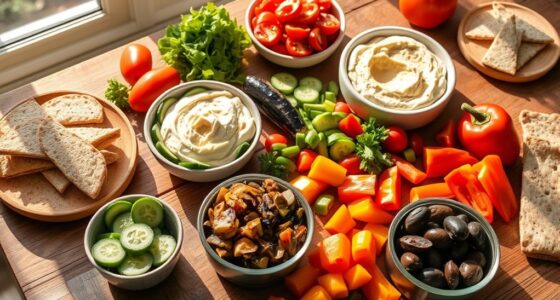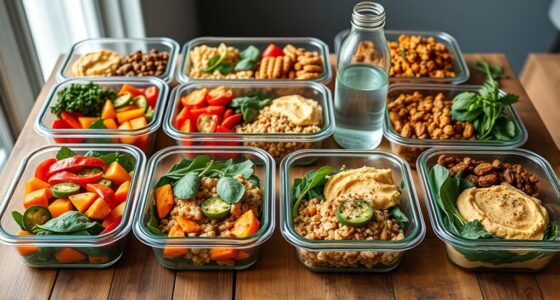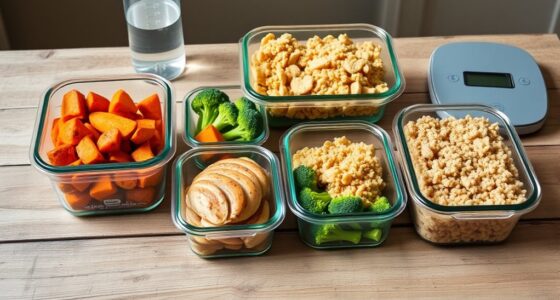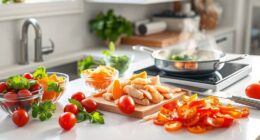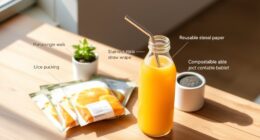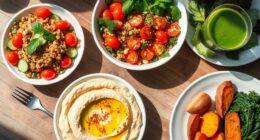To start meal prep easily, gather key tools like airtight containers, portioning bags, a digital scale, and reheatable cookware. Focus on simple, versatile recipes that store well in bulk, and plan your grocery list carefully. Batch cooking saves time and helps control portions, reducing waste and overeating. By organizing these basics, you’ll build a smooth routine that keeps healthy meals ready — and there’s plenty more to discover as you continue!
Key Takeaways
- Choose versatile containers like glass or BPA-free plastic for storing prepped meals and individual portions.
- Prioritize simple recipes that store well and reheat easily, such as stews, roasted vegetables, and grilled proteins.
- Dedicate specific time weekly, like weekends, for batch cooking to maximize efficiency and consistency.
- Use digital scales, measuring cups, and portion containers to ensure accurate servings and maintain dietary goals.
- Plan your grocery list carefully based on your meal plan to minimize waste, save money, and streamline shopping.

Have you ever wondered how to save time and eat healthier throughout the week? The secret lies in effective meal prep strategies, and two key techniques can make a big difference: batch cooking and portion control. When you batch cook, you prepare large quantities of meals at once, which means fewer daily cooking sessions and more consistent, nutritious options ready to go. This not only saves you time but also helps you resist the temptation of grabbing unhealthy takeout or snacks. To start, pick a couple of favorite recipes that store well—think hearty stews, roasted vegetables, or grilled chicken—and dedicate a block of time on the weekend or a less busy day to prepare. Cook everything in bulk, then divide it into individual servings using containers. This way, you’ll always have a wholesome meal waiting, regardless of how hectic your day gets.
Portion control is equally essential for maintaining a balanced diet and avoiding overeating. After you’ve batch cooked your meals, portioning them into single-serving containers ensures you consume just the right amount each time. It simplifies your decision-making process—no more guessing or second-guessing how much to eat. Use clear containers or pre-measured bags, and consider investing in a digital scale for precise portions, especially if you’re tracking macros or calories. When you portion your meals ahead of time, it encourages mindful eating since you’re not tempted to go back for seconds. Plus, it helps you stick to your dietary goals without feeling deprived, because you’re in control of your servings. Incorporating mindfulness techniques during your meal times can further enhance your awareness of hunger cues and improve your relationship with food.
Another advantage of combining batch cooking with portion control is that it streamlines your grocery shopping. When you plan your meals and portion sizes, you’ll know exactly what ingredients and quantities you need, reducing food waste and saving money. It also makes grocery shopping more efficient—no more wandering through aisles unsure of what to buy. As you get used to this routine, you’ll notice how much easier it becomes to stay organized and committed to your healthy eating goals. Remember, the key is consistency; the more you practice batch cooking and portion control, the more natural it will feel. Over time, these techniques will become second nature, empowering you to make smarter choices and enjoy delicious, nutritious meals without the daily hassle.
Frequently Asked Questions
How Do I Choose the Right Containers for Meal Prep?
You should choose containers based on their materials and portion sizing. Opt for durable, BPA-free plastics or glass for safety and reusability. Consider container sizes that match your typical meal portions, ensuring they’re not too large or small. Look for leak-proof lids and microwave-safe options for convenience. By matching container materials and portion sizes to your needs, you’ll keep meals fresh and prep efficient.
What Are Some Budget-Friendly Meal Prep Ideas?
You can save money by using cost-effective ingredients like beans, rice, and seasonal vegetables for meal prep. Focus on affordable cooking methods such as batch cooking and steaming to maximize your budget. Plan meals around sales and use versatile ingredients to create variety without extra cost. Preparing simple, nutritious dishes at home helps you stick to your budget while enjoying delicious, healthy meals throughout the week.
How Long Can Prepped Meals Be Safely Stored?
Think of your prepped meals as treasures in a safe. Food safety and storage duration are key to keeping them fresh. Generally, you can store cooked meals in the fridge for 3 to 4 days, and in the freezer for up to 3 months. Always check for signs of spoilage before eating. Proper storage guarantees your meals stay safe, tasty, and ready when you need them.
What Are Tips for Avoiding Food Boredom?
To avoid food boredom, focus on adding flavor variety by experimenting with different herbs, spices, and sauces. Rotate ingredients regularly to keep meals interesting and prevent monotony. You can also try new cooking methods or cuisines to spice things up. Keep your meals appealing by mixing textures and colors, making each dish exciting. This approach guarantees you stay motivated and enjoy your meal prep journey while maintaining a balanced diet.
How Do I Adapt Meal Prep for Special Dietary Needs?
To adapt meal prep for special dietary needs, focus on gluten-free substitutions like rice, quinoa, or gluten-free oats, and incorporate vegan meal options such as beans, tofu, and vegetables. You can customize recipes to fit your restrictions and still enjoy variety. Always read labels carefully, experiment with new ingredients, and plan ahead to make sure your meals are nutritious, satisfying, and compliant with your dietary requirements.
Conclusion
Now that you’ve got the basics down, meal prepping can become a gentle dance rather than a formidable task. With a few trusty tools and simple techniques, you’ll find it easier to stay on track and enjoy your meals without feeling overwhelmed. Remember, a little planning goes a long way—think of it as giving yourself a cozy cushion of confidence. Keep practicing, and soon, meal prep will feel like a warm, welcoming routine you genuinely look forward to.
Ilana has been a vegan for over 10 years. She originally made the switch for health reasons, but soon found herself becoming more and more passionate about the ethical and environmental implications of a vegan lifestyle. Ilana is the author of The Graceful Kitchen, a blog all about veganism. She loves to cook up delicious and nutritious vegan meals, and share her recipes with others who are interested in leading a cruelty-free life. Ilana is also a strong advocate for using whole foods as the foundation of a healthy diet, and believes that going vegan is one of the best ways to achieve this.



